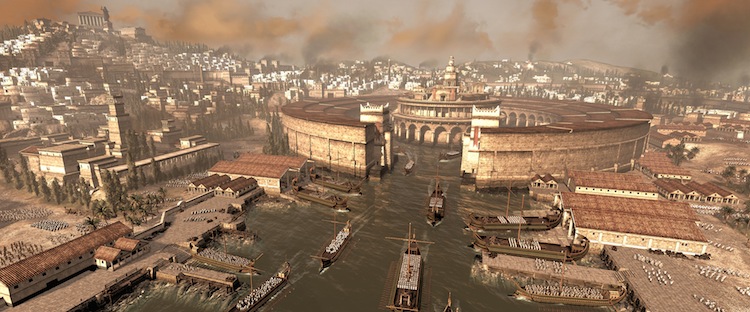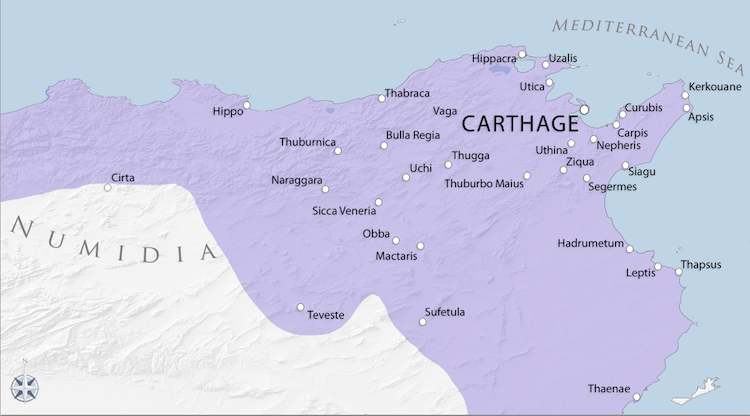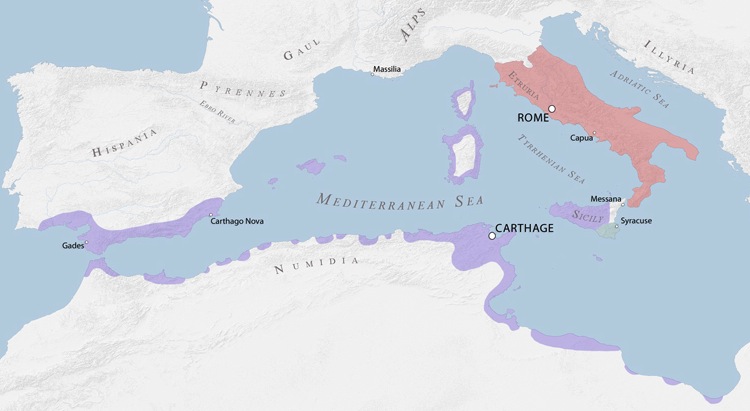Early History of Carthage
Legend holds that Carthage was founded around 825 BC by Queen Dido who had fled from the city of Tyre to escape her murderous brother Pygmalion. Archaeological evidence confirms that Phoenician traders from Tyre founded the city of Qart-Ḥadašt—or "New City," as Carthage was known in its native language—in the second half of the ninth century BC. The settlement of Carthage was part of a centuries-long pattern of colonization by the Phoenicians in the eastern Mediterranean aimed at controlling the lucrative trade in tin, gold, silver, and copper. Eventually the Phoenicians established over 300 coastal colonies throughout North Africa and the Iberian Peninsula (Hispania).
By the third century BC, an independent Carthage had grown into one of the more powerful states in the Mediterranean, controlling much of North Africa, Sardinia, and Corsica, along with sections of Sicily and the Iberian Peninsula. The city itself grew to be the second largest in the ancient Mediterranean, behind only Alexandria, the magnificent capital of Ptolemaic Egypt. With its powerful fleet, Carthage dominated trade throughout the western Mediterranean and even into the Atlantic.
Carthage had slowly evolved from a colony to the capital of a new empire. As the city grew in size and power during the seventh century BC, it progressively asserted its independence from Tyre, founding colonies of its own and expanding its territory in Africa. Even so, Carthage continued to signal its allegiance to its mother city by dispatching an annual embassy to Tyre's temple of Melquart, the city's patron diety. After Tyre was conquered by the Babylonians in the early sixth century, the Phoenician colonies in the western Mediterranean turned to powerful Carthage for protection and support against their Greek rivals. Old Phoenician colonies, such as Utica and Gades in Hispania, became bound by treaty to Carthage. Carthage's approach to its allies differed from that developed by Rome. While Roman allies participated in a mutual defensive organization under the leadership of Rome, which gradually integrated its allies by granting their people rights and even citizenship, Carthage preferred to extract punitive taxes from its looser confederation of subjects and subject allies. These taxes were used in turn to finance Carthage's fleet and to pay mercenary soldiers.
Despite their extensive contact with their Greek neighbors and Libyan subjects, the Carthaginians retained their Punic language, a dialect of Phoenician and a Semitic language related to Hebrew. Punic would long outlast Carthage's empire. It was still spoken in northern Africa as late as the fifth century AD, but died out soon thereafter, leaving only a few inscriptions and scattered quotations as witnesses. The Carthaginians also retained distinctive customs, including the sacrifice of infants to Baal Hammon and his consort Tanit, a practice that had long since been abandoned in Tyre and the other Semitic kingdoms of the Levant. Recently, scholars have questioned whether the Carthaginians engaged in widespread child sacrifice, or if it was reserved for especially dire moments, or if the substantial archaeological evidence indicating such sacrifice has been misinterpreted, colored by the biased accounts of Carthage's enemies, from whom we derive most of our information about the city and its people. It remains a controversial question.
As the head of a Punic coalition, Carthage forged anti-Greek alliances with the Etruscans, who controlled Rome until the late sixth century BC. They also courted the support of the far-off Persians, who were attempting to conquer the Greeks in the eastern Mediterranean. It was said in antiquity that on the same day when the united eastern Greeks destroyed the fleet of the Persian King Xerxes at Salamis in 480 BC, a coalition of western Greeks routed a Carthaginian force at Himera in Sicily. This coincidence is almost certainly a later fabrication, but it does signal how events throughout the eastern and western Mediterranean were understood to be part of one grand narrative in antiquity. After their defeat at Himera, the Carthaginians avoided open conflict with the Greeks in Sicily, turning their attention instead to expanding their territory in Africa, exploring and colonizing the Atlantic coast (perhaps as far south as modern Cameroon), and developing their inland trade routes to the south.
As Carthage emerged as a major military power, its political system was evolving from a monarchy to a more inclusive republican form of government—a transformation experienced by many other city-states throughout the ancient Mediterranean at this time, including Rome. Eventually, Carthage's government came to be led by two annually elected magistrates (suffetes or "kings"); a Council of Elders (the adirim or "Mighty Ones") consisting of the leading men of the city; and an assembly of citizens, who could arbitrate between the suffetes and Council when they were at odds. Unlike the Romans, whose annually-elected magistrates managed both civilian and military affairs, the Carthaginians created a separate office of general, who was appointed for a specific mission and who would continue in office until that mission was completed. As a result, these generals could accumulate considerable power. Their power was checked, however, by the Council of 104 judges, who had the power to convict and crucify delinquent generals. Carthage's political system was often praised in antiquity: Aristotle thought Carthage possessed one of the best constitutions. In practice, however, a single preeminent family often acquired political supremacy for extended periods of time. Sometimes this family would rule collaboratively with other members of the aristocracy; at others, it would exercise near absolute authority in the city.
To understand the savage tenacity displayed by the Carthaginians and Romans in the Second Punic War, it is necessary to understand the previous conflicts between the two powers. Early in their history, Rome and Carthage signed several treaties of friendship and even fought as (somewhat unenthusiastic) allies against adventuring Greek potentates. But Rome's growing involvement with Carthage's Greek adversaries in southern Italy and Sicily—combined with Rome's traditional fear of powerful neighbors—caused tensions between the two powers to increase. Beginning in 264 BC, Rome and Carthage would fight three brutal wars for control of the western Mediterranean. Collectively these conflicts are known as the Punic Wars after the Latin word for "Phoenician," Poenus.





